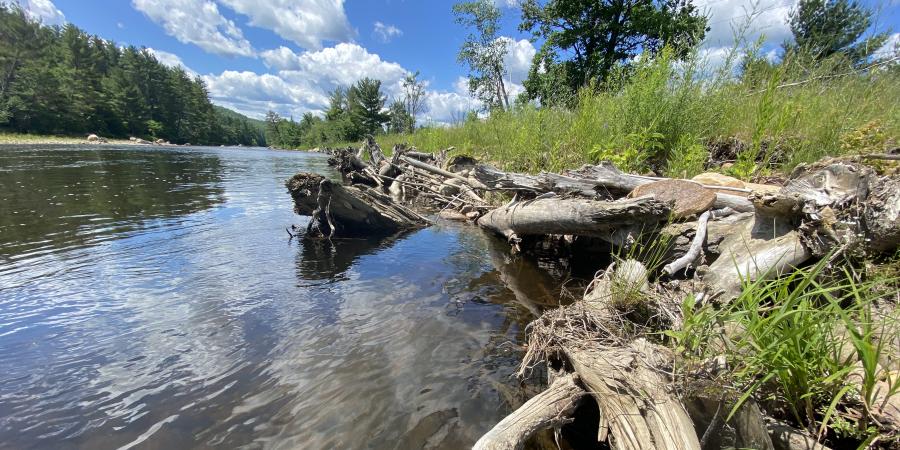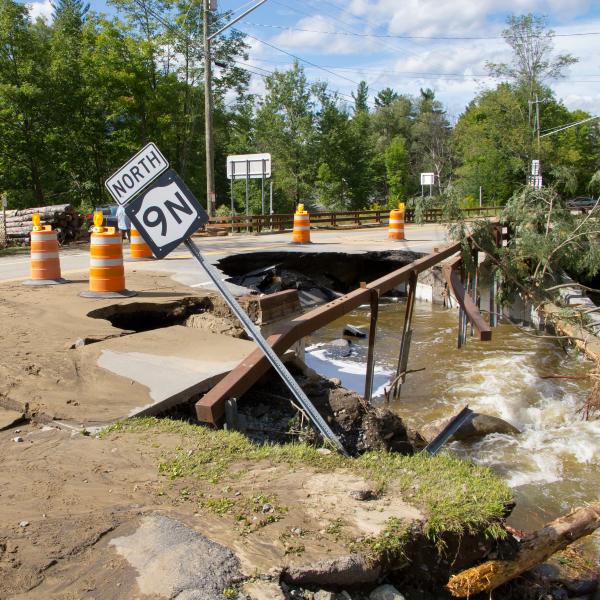While log drives may be history on the Ausable River and elsewhere in the northern forest, stray logs and trees still find their way into rivers and their tributary streams. Have you ever paid attention to that branch that fell across the stream or river you live next to or drive past? Sometimes it moves on quickly, while another might stay in place, maybe serving as your footbridge or waterfall for decades until it rots away. It is ironic, given the damage done by large-scale historical log drives, that natural inputs of woody material from storms, old age, and high flows are always good for streams. Indeed, wood is essential to the health, structure, and biodiversity of streams in this region.
Stream lovers know that wide riparian buffers of native trees and woody plants provide essential benefits. Their shade cools stream edges, their roots absorb storm and flood water and stabilize banks, and their foliage provides food and habitat for birds and insects. But what happens when a tree topples into a stream? Remember, subtle bank erosion and shifts in the course of a channel are natural in wild streams. Streams alter course, banks fail, lightning strikes – a host of natural processes lead to live and dead limbs and whole trees falling into streams. This wood is incorporated into the ecosystem and serves a variety of beneficial purposes.
![]()
In this small tributary stream, fallen logs and cobbles together form structure and roughness in the streambed.
Beyond providing a possible stream crossing for people and other animals, downed trees create habitat and diversity. The large tree stranded mid-channel with its roots buried in the deep channel, or the large limb laying against the bank with its branches in the water, adds diversity to the aquatic habitat. Exposed portions above water provide basking areas for turtles and perches for birds and small mammals. Below the water, fish benefit in several ways. Fine gravel typically collects upstream of large woody debris as flows slow, creating spawning habitat. As water flows over and around submerged tree limbs, it scours and undercuts adjacent areas of the channel, creating small pools and pockets. We call this habitat heterogeneity, or habitat diversity. Instead of being a barrier to fish passage, woody debris can make it easier for fish to move upstream. The complex habitat also provides shelter for fish to rest, reside, or feed during low flows in summer.
The fallen tree helps feed the aquatic food chain from the bottom up. As it settles in place for the long term, wood provides a surface for algae to grow on and often traps smaller sticks, leaves, and other organic material: food sources for a variety of aquatic macroinvertebrates.

Trees and other large woody material that have fallen from stream banks into the channel provide many physical and biological benefits.
As large wood settles into a channel, it helps maintain stream stability. If you walk along the banks of steeper small streams, you’ll see wood integrated into established cobble and boulder steps or lining the sides of deeper pools, serving with bedrock and cobble as the building blocks of the channel. Wood embedded across streambanks and into channels creates roughness that can slow higher flows of water and collect sediments, building both bed and banks. Large wood also creates connections between the channel and the floodplain – helping to move flood water, sediments, and nutrients out of the channel, to be absorbed and deposited, reducing flood stress and potential damage downstream.
In recent decades, large wood has been removed from streams because it has been perceived as unattractive or as a threat during floods. In some cases, judicious removal may be needed for public safety. With only a few exceptions, however, wood should be allowed to move and integrate into stream ecosystems. Healthy, diverse streams have the capacity to store and utilize significant quantities of wood. The enormous benefit wood provides has made it a critical element in natural stream restoration, particularly toe wood structures to restore eroded outer bends of streams. On a river the size of the West Branch Ausable River, toe wood is constructed of 60 to 80-foot trees, 18 to 24 inches wide, laid horizontally, angled slightly downward toward the water with 10-15 feet between each intact root crown. Natural materials are layered and anchored on top of the trees so that, in a year’s time, the bench will blend in with other healthy banks. Toe wood plays a vital role as water rises. In a bankfull or high spring flood, water will move up onto the bench, slowing its downstream velocity and providing protection for adjacent areas. The toe wood is resilient, easily withstanding high flows and ice, providing habitat, absorbing stream energy, slowing flood water, and angling it back into the channel. Toe wood, well placed, mimics the natural occurrence of wood in healthy streams, gathering fine sediment and creating habitat.
Large wood constructions are essential elements of many Ausable River Association restoration projects because they are stable in floods. They also provide opportunities for rapid growth of native plants, creating a rich riparian buffer. Engineered banks constructed of stone, designed to keep water in the channel, transfer flood effects downstream and minimize growth of plants and trees. Large wood, such as designed toe wood benches along a channel, becomes a platform for new riparian growth on banks. And the cycle continues. Wood is good.
Story written by Carrie Pershyn, Biodiversity Research Manager and Kelley Tucker, Executive Director.
Sign-up for our e-newsletter to get weekly updates on the latest stories from the Ausable River Association.




